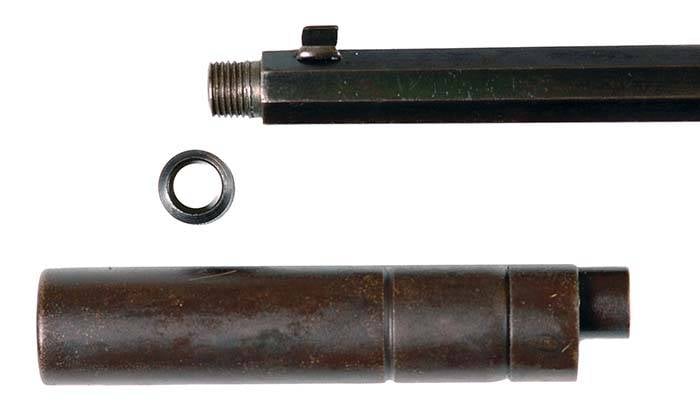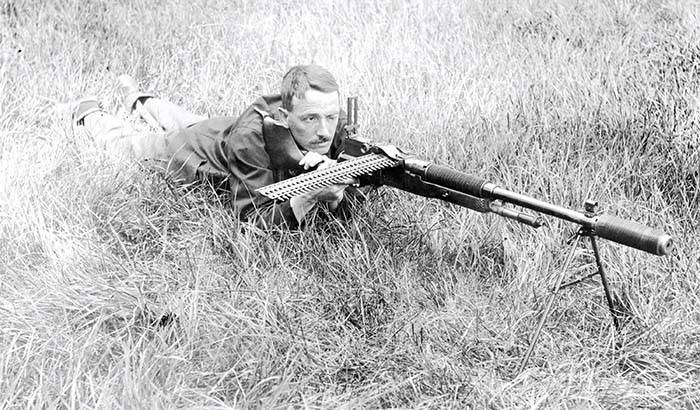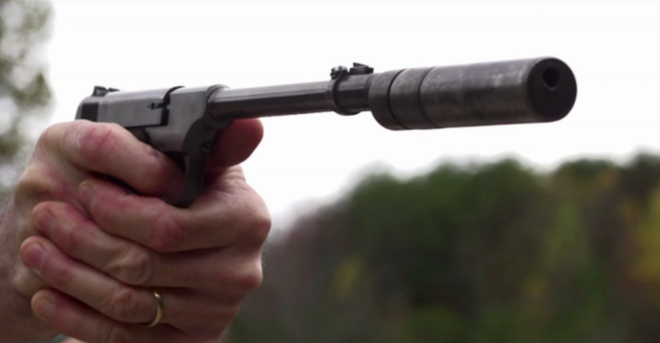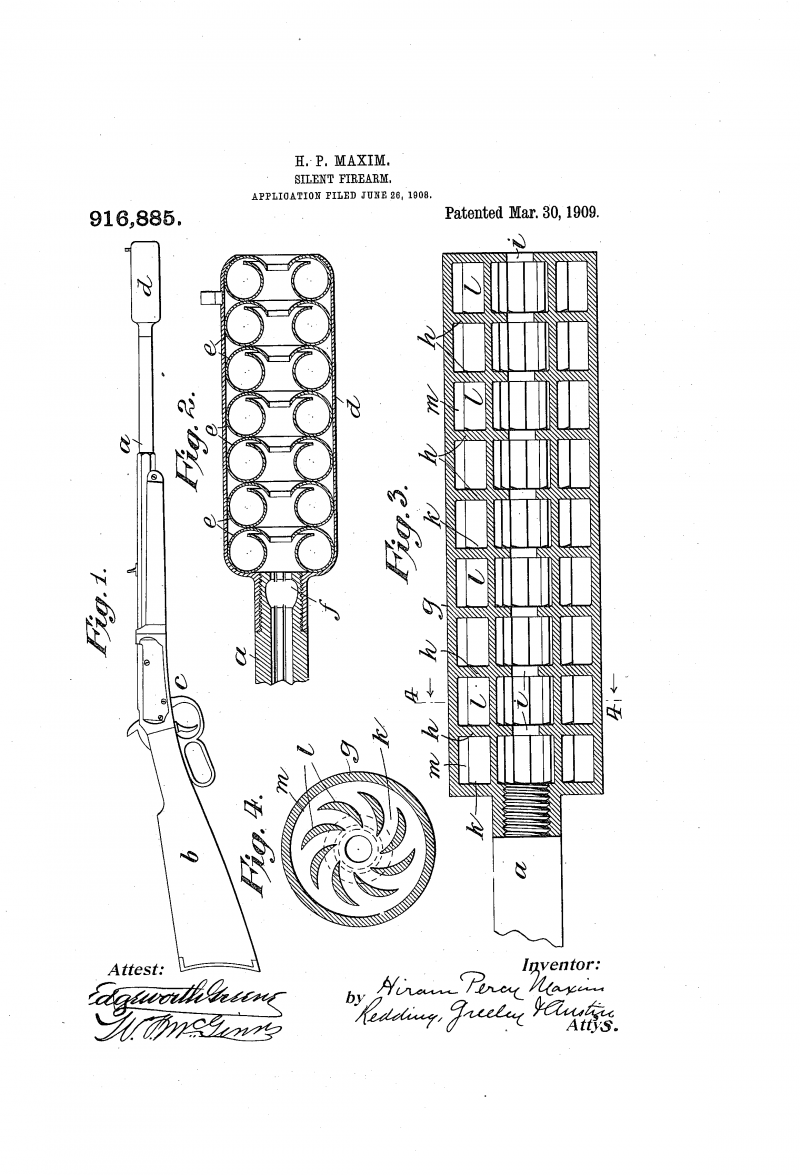Devices of silent shooting Maxim Silencer (USA)
At the turn of the century, the American inventor Hiram Percy Maxim (son of Hiram Stevens Maxim) studied ways to reduce the noise produced by internal combustion engines. Quickly enough, he noticed that a significant proportion of the total noise was generated by hot exhaust gases. Thus, equipping the exhaust manifold with a special device could lead to a sharp decrease in the noise level of the car. Soon, the designer offered several variants of a car muffler, in which the same ideas were implemented in different ways.

The Maxim Silencer device (below) and the rifle barrel, prepared for its installation. Photo by Smallarmsreview.com
The silencer of Maxim's design was a device in the form of a volumetric case, inside of which a set of partitions of various shapes and sizes was placed. It was assumed that hot gases, colliding with partitions, will lose speed and some of their energy. For this reason, the pressure in the volume of the silencer will decrease, and the outflowing gases with a lower temperature will produce less noise.
Soon H.P. Maxim came to the conclusion that such principles of noise reduction from hot gases can be applied not only in the automotive industry. There were similar noise problems in the area of small weapons. A simple analysis of the situation showed that they can also be solved with the help of previously proposed devices.
As you know, the noise of a shot is formed by several phenomena. One of its main components is a shock wave formed by hot powder gases. It was with this phenomenon that all early designs of noiseless firing devices, including the design device H.P. Maxim. Coming out of the barrel, the gases had to fall into the chambers of a special configuration and lose energy there. Outwardly, into the atmosphere, the gases were vented at reduced pressure and with reduced temperature.
Already in 1902, the inventor completed the development of a new device for weapons and began preparations for its mass production with the aim of massive sales. It was planned to launch a silent-firing device called Maxim Silencer under the name Maxim Silencer. Nevertheless, the launch of mass production was noticeably delayed. Design improvements took several years, after which the designer engaged in the registration of his invention. In the middle of 1908, a patent application was filed, and the document itself was issued in the spring of 1909. Only after that the company Maxim Silencer Company was able to begin production and sale of devices.
Wanting to get the maximum possible market share, H.P. Maxim made five silencers suitable for use with a wide range of weapons of different types. According to the manufacturer, Maxim Silencer of various modifications could be installed on any rifle caliber from .22 to .45, for which the appropriate adapters were used. It was argued that Maxim’s company also created silencers for smooth-bore guns, but at that time they were not ready for mass production and sales. Serial products for use with pistols or revolvers were still at the design stage and were not ready to enter the market.
The silencer had a simple and utilitarian look. The buyer was asked to use a cylindrical device, on the front wall of which there was a hole for the bullet, and on the back there was a nut for mounting on the weapon. The product did not need special maintenance during operation and therefore could not understand. For greater rigidity on the outer surface of the cylindrical body there were several transverse grooves.
The case of the silent shooting device was distinguished by maximum simplicity and consisted of several main parts that had relatively large dimensions. Its main elements were a metal cup of large elongation and a front cover. The bottom of the glass had a hole on which was located the nut for mounting on the weapon. An interesting feature of the case and internal parts was the asymmetrical arrangement of the channel for the passage of a bullet. The longitudinal cavity channel was located significantly above the axis of the housing. Due to this, the upper surface of the silencer mounted on the weapon was located relatively low and did not overlap the aiming line.
The task of retaining the powder gases and eliminating the formation of a muzzle wave was assigned to a number of partitions placed inside the cylindrical body. Along the entire length of the body, it was necessary to install a dozen and a half metal stamped partitions of a special form, correctly distributing the flow of gases and preventing them from directly passing through the muzzle opening.
All partitions had the same shape corresponding to the problem to be solved. The metal blank in the form of a disk is bent over the edges, forming a kind of torus. At the same time, there was a noticeable gap between the curved edges of the part and its center. The central portion of the disk was pressed downward, and in addition, a round hole of relatively large size appeared in it. The hole for the passage of the bullet was shifted to the upper part of the body. The partition was installed in the housing so that its curved edges turned to the rear wall and the inlet. The body of the muffler could accommodate a half dozen of such partitions, tightly "stuffed" into the existing cavity.
It should be noted that in the 1909 patent, two structures of internal partitions were described at once. The first involved the use of curved partitions, similar to those used in serial silencers. The second option was to use a longitudinal tube with perforations, on which transverse partitions with radial holes should be mounted. In this case, a large volume was formed between the longitudinal tube and the outer casing divided by partitions into several annular chambers. As far as we know, the second layout option was not used in Maxim Silencer serial products.
The project proposed the use of the Maxim Silencer silencer with rifles of various models. To ensure this compatibility, H.P. Maxim and his colleagues developed a whole line of muzzle devices that performed the functions of an adapter. Most of these devices were parts of varying diameter, the back of which had an internal thread for mounting on the barrel. The dimensions of the shank corresponded to the parameters of a compatible rifle. In all cases, the front part of the adapter had the same diameter, which ensured connection with the device for silent firing. For some rifles, characterized by a large outer bore diameter or increased cartridge power, collapsible adapters were proposed, consisting of three or four parts. In all cases, an airtight connection of the weapon with a muzzle device was ensured, preventing the leakage of gases.

Installation of the muffler on the trunk using an adapter (in the center). Picture from advertising brochure
The catalog company H.P. Maxim had two dozen adapters. Thanks to this, the silencer could be used with rifles of more than 50 models from all leading manufacturers. Adapters provided the Maxim Silencer installation on weapons with an outer barrel diameter from 0,431 inches (10,95 mm) to 1,08 inches (27,43 mm).
In 1909, five modifications of the Maxim Silencer product, intended for weapons of various calibers, entered the market at once. There were silencers for rifles of the .22, .25-20, .32-20 and .32 rifles. An enhanced version of the device, compatible with military weapons, was also developed. Together with devices of silent firing, two dozen adapters were brought to the market.
New devices differed relatively small size. Thus, the Maxim Silencer length for rifles of the .22 caliber was 4,88 inches (124 mm) with a diameter 1,35 inches (34,29 mm). Product weight - 6,8 oz (slightly less than 2 kg).
An interesting feature of the new products was their relatively low price. So, for the silencer to the rifle caliber. 22 asked only 5 dollars (less than 140 dollars at current prices). A complete set for the .32-20 rifle, which included a silencer and a set of additional devices, cost 7 dollars (about modern 195). The most expensive option was a silencer for a Springfield rifle - 8 dollars 50 cents (about 235 dollars in current prices).

The device of silent shooting on a rifle. Photo by Smallarmsreview.com
The principle of the "Maxim Silencer" was quite simple. Coming out of the barrel, the bullet hit the longitudinal channel of the device, formed by the holes in the partitions. Without encountering any resistance, she left the silencer and set off toward the goal. The powder gases following it, being under great pressure, collided with partitions and slowed down. They were distributed in numerous internal cavities formed by partitions, and as a result, they lost energy. When the gases nevertheless reached the front outlet, their speed, pressure and energy did not allow creating a noticeable shock wave.
The manufacturer did not hesitate to make loud statements in advertising. According to the published brochure, the Maxim Silencer product completely excluded any noticeable noise of a shot. However, gunsmiths admitted that the silencer can not do anything with the shock wave formed during the flight of a high-speed bullet. As the tests showed, the vertical transverse partitions inside the muffler worked like a muzzle brake and reduced the recoil momentum acting on the arrow by about two thirds.
H.P. noiseless firing devices Maxim sold in closed and sealed form. Disassembly of the device for service is not provided. According to the instructions, all the necessary operations could be done without disassembling the device. After firing with the use of cartridges on smokeless powder, it was necessary to remove the muffler from the weapon and shake it properly. If, after shooting, unburned pellets of gunpowder remained in his cells, they should have fallen out. When using black powder, more complex cleaning was required. In this case, the device should be left for half an hour in warm water, so that it fills all the internal cavities and washed away the soot. The use of cleaning agents, solvents, etc. was also permitted.
The first silencers of the Maxim Silencer Company, which received the brand designation Model 1909, were sold, in general, not bad, but the inventor did not rest on his laurels and started developing the design. Already in 1910, an updated version of the design appeared, which was distinguished by reduced dimensions and weight. The next upgrade was in 1912, and also led to an improvement in some features.

The army also became interested in noiseless firing. Photo by Smallarmsreview.com
Initially, amateur shooters who wanted to reduce the noise of their weapons were considered as potential buyers of silent shooting devices. However, later a version of such a product was created for the Springfield rifle, which soon became the subject of an order of the National Guard. After the outbreak of the First World War, the US Army ordered a number of such products to equip snipers.
After the war, the volume of orders from government agencies fell sharply, and the sale of silencers to the population again became the main way of earning money. As the issue continues, the company H.P. Maxima continued to improve her products, making certain changes of a constructive or technological nature. A similar situation persisted for some time and allowed Maxim Silencer products to get a noticeable spread.
At the beginning of the twenties, a silent-shooting device was launched for pistols. It could be used with different types of weapons having a fixed barrel. The use of a silencer on pistols with a moving barrel was not recommended. A relatively heavy device interfered with the correct rollback or displacement of the trunk in the vertical plane, and therefore did not allow the automatic gun to work properly.
The favorable market situation persisted for a long time, but in the mid-thirties the situation changed dramatically. In 1934, the US government introduced new laws in the field of civilian small arms. Among other things, the new standards affected the scope of silent firing devices. These devices did not prohibit, but their turnover was imposed duty in 200 dollars (more than 3600 dollars in current prices). Not the largest market silencers could not survive such innovations. All manufacturers of such equipment were forced to curtail its production due to lack of demand. The secondary market also ceased to exist.

Product Maxim Silencer on the gun. Photo by Thefirearmblog.com
After the introduction of new rules and regulations, the company Hiram Percy Maxima, as well as its competitors, was forced to withdraw from the production devices silent shooting. However, she did not have to complete her activities. By this time, Maxim Silencer Company produced not only accessories for weapons, but also automobile silencers. Such production allowed her to survive the rejection of part of the products. In addition, the production of automotive components was increased by attracting the released production capacity.
From the late nineties to the mid-thirties, the Maxim Silencer Company, according to various sources, managed to produce up to several tens of thousands of silencers designed by HP. Maxim number of modifications and models. A significant number of these products were released to the civilian market, while a considerable amount of products was immediately supplied to the army and the National Guard. Such devices have found application in various fields and enjoyed a certain popularity. However, over time, all operators abandoned them. Civilian shooters had to forget about the silencers due to the emergence of new laws, and army snipers switched to new, more advanced equipment.
The idea of a silent-gun weapon, which reduces the volume of a shot by holding the powder gases and quenching their energy, appeared at the end of the 19th century. However, the first serial products of this kind appeared on the market only a few years later. Hiram Percy Maxim's silencer became one of the most successful early developments in his field and took a well-deserved place in stories small arms.
Based on:
https://forgottenweapons.com/
http://smallarmsreview.com/
http://thefirearmblog.com/
http://google.com/patents/US916885


Information